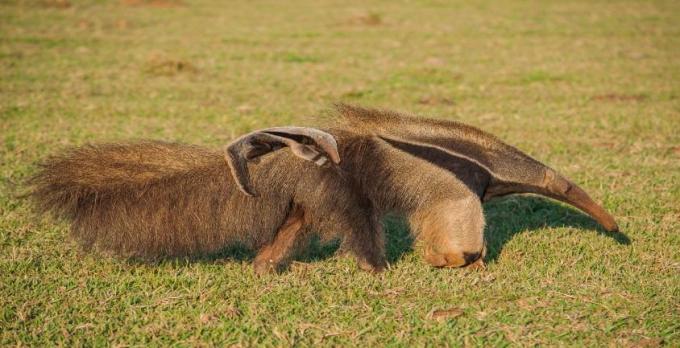Have you ever seen someone use the span or step to measure the length of something? For a long time it was in this way (with parts of the body) that people expressed measurement of length.
But, due to the need to facilitate communication between scientific and commercial communities around the world, around the year 1790, the Decimal Metric System, in which the subway, which we use today, is the fundamental unit of measurement.
Let's know more about the subway and yours multiples and submultiples?
Index
- The Metro
- the multiples of the metro
- Submultiples of the metro
- transforming measures
- Examples - Transforming Measures
The Metro
O subway (m) is the fundamental unit of measurement of length in the Decimal Metric System.
We use the meter when, for example, we mean the height of a person, the width of a room, the height of a house, etc.
To express large measures, such as the distance from one city to another, or small measures, such as the height of a bottle cap, we have the multiples and submultiples from the subway.
the multiples of the metro
For long distances, the most suitable is to use the multiples of the meter: o dekameter, O hectometer it's the kilometer, on what:
- 1 decameter (dam) = 10 meters
- 1 hectometer (hm) = 100 meters
- 1 kilometer (km) = 1000 meters
Submultiples of the metro
For short distances, we have the metro submultiples: o decimeter, O centimeter it's the millimeter, such that:
- 1 decimeter (dm) = 0.1 meter
- 1 centimeter (cm) = 0.01 meter
- 1 millimeter (mm) = 0.001 meter
In other words:
If we divide the meter into 10 equal parts, one of these parts corresponds to 1 decimeter;
If we divide the meter into 100 equal parts, one of these parts corresponds to 1 centimeter;
If we divide the meter into 1000 equal parts, one of these parts corresponds to 1 millimeter.
transforming measures
Consider the following situation:
To get to the front door, Ana walked 5.63 m and Laura, 423 cm. Who traveled the farthest distance?
To answer this question, we need to know how far each one traveled, considering the same unit of measure.
Let's transform the distance traveled by Ana to centimeters (we could also transform the distance traveled by Laura to meters).
In length measurement transformations, we can rely on the following table:

Note that to exit m and go to çm, in the table, we have to do two "jumps" to the right. In each of these "jumps", we must multiply by 10, that is:
-
5,63m
cm:
1st "jump":5.63 m = (5,63 x 10) dm = 56.3 dm (In the first "jump" we left m and we arrived in dm)
2nd "jump":56.3 dm = (56,3 x 10) cm = 563 cm (In the second "leap" we left dm and we arrived in cm, as we wanted)
Then, 5.63 m it's the same as 563 cm. Thus, we arrived at the answer to this problem, Ana was the one who covered the longest distance, 563 cm.
- Free Online Inclusive Education Course
- Free Online Toy Library and Learning Course
- Free Online Math Games Course in Early Childhood Education
- Free Online Pedagogical Cultural Workshops Course
But we have a more practical way to reach that same result. Look:
We took two "jumps", in each "jump" we multiply by 10. Doing this is the same as multiplying directly by 100, since 10 x 10 = 100. Watch:
-
5,63m
cm:
5,63 x 100 = 563
Then, 5,63m = 563 cm
We will see some more examples, but this time doing it directly by more practical method.
Examples - Transforming Measures
Perform the following length measurement transformations:
-
Transform 8 meters into millimeters:8 m
mm
We multiply by 1000, as there are three "jumps" to the right:
8 x 1000 = 8000
Soon, 8 m = 8000 mm.
- Turn 5 meters into decameters: 5 m
dam
Here, we divide by 10 because it's a “leap” to the left:
5 10 = 0,5
Thus, 5 m = 0.5 dam.
- Turn 12 cm into meters: 12 cm
m
We divide by 100, as there are two "jumps" to the left:
12 100 = 0,12
Then, 12 cm = 0.12 m.
- Transform 1250 meters into kilometers: 1250 m
km
We divide by 1000, as there are three "jumps" to the left:
1250 1000 = 1,250
Thus, 1250 m = 1,250 km.
To memorize:
If I go to the right, then multiply. If I go to the left, then I share.
I multiply and divide by how much? 10 for 1 “jump”, 100 for 2 “jumps” and 1000 for 3 “jumps”.
Read too:
- Multiplying Decimal Numbers - Learn How to Multiply Numbers with Comma
- How to turn kilometers into miles? – Formula and examples
- How to write a number in scientific notation? – Changing the comma position and examples
The password has been sent to your email.



